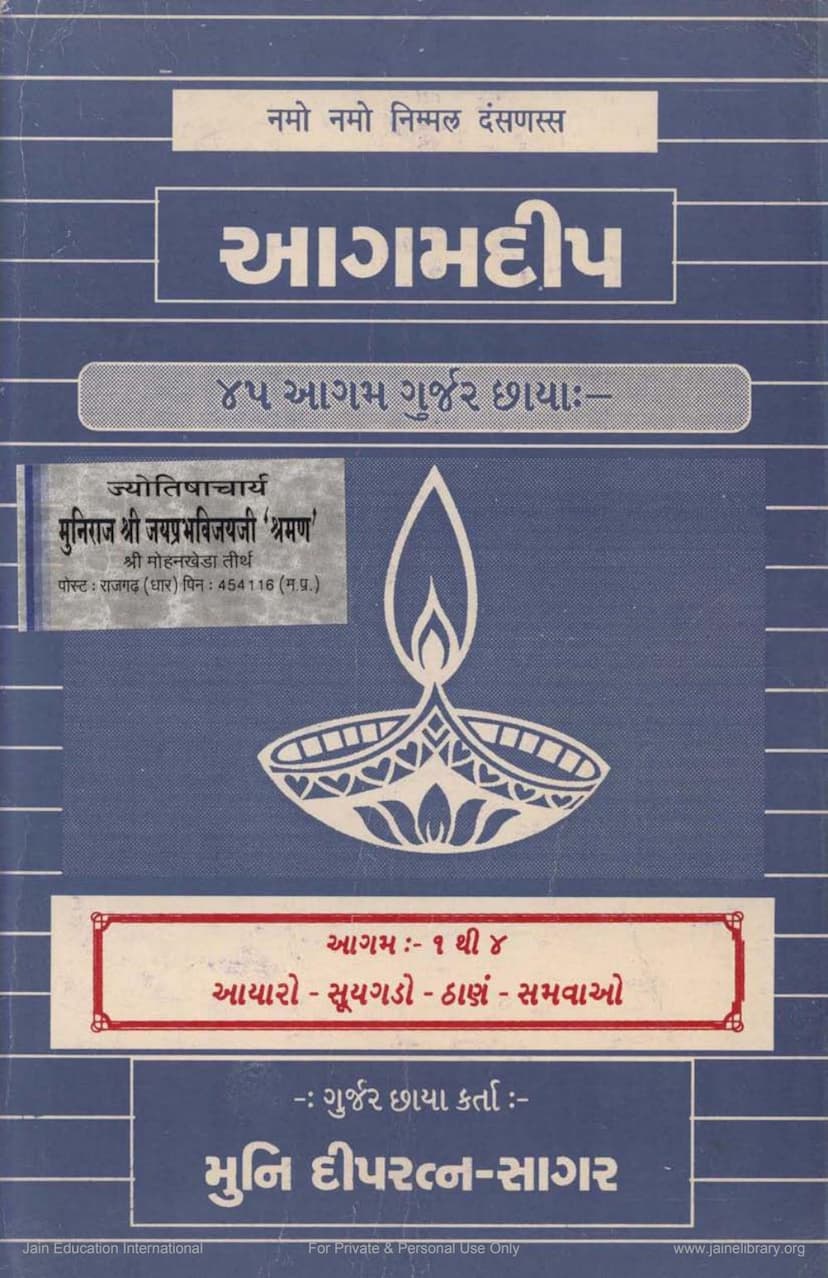Agam Deep 15 Pannavana Suttam Gujarati Anuvaad
Added to library: September 1, 2025

Summary
This is a comprehensive summary of the Jain text "Agam Deep 15 Pannavana Suttam Gujarati Anuvaad" by Dipratnasagar, Deepratnasagar, published by Agam Shrut Prakashan. The text provides a Gujarati translation and commentary ("Gujar Chhaya") of the fifth Upanga Sutra, the Pannavana Sutra (also known as Prajnapana Sutra), attributed to Muni Dipratnasagar.
The document is structured into several "pads" (sections) and "udeshas" (chapters/divisions), detailing various aspects of Jain philosophy and cosmology as explained in the Pannavana Sutra.
Here's a breakdown of the key themes and content covered in the provided pages:
I. Introduction and Context (Pages 1-8):
- Invocation and Salutations: The text begins with traditional Jain invocations, paying respects to the pure doctrine, the great soul Lord Mahavir, and spiritual preceptors.
- Publication Details: It identifies the author, publisher, and provides contact information for the publication. The price of the "Agam Deep Gujarati Chhaya" is mentioned as ₹2000.
- The "Agam Deep" Series: This particular volume is part of a larger series ("Agam Deep") aiming to illuminate Jain scriptures. It covers Agamas 1-4 (Acharya, Suyagada, Thana, Samavaya) in previous volumes. This volume focuses on the 5th Upanga Sutra.
- Financial Support: The publication acknowledges key financial contributors, highlighting the community support for disseminating these important texts.
- Listing of Agam Sutras: An extensive list of Jain Agam Sutras is provided, indicating the scope of the "Agam Deep" series and the place of the Pannavana Sutra within the Agamic canon.
II. Content of the Pannavana Sutra (Pages 12 onwards):
The core of the text delves into the detailed exposition of the Pannavana Sutra, which is primarily concerned with the classification and enumeration (prajnāpanā) of various categories of existence. The summary highlights the following key areas:
-
Prajnapana (Classification/Enumeration): The text explains that Prajnapana deals with various "pads" (terms or concepts), which are extensively enumerated. Thirty-six principal "pads" are listed, including:
- Prajnapana (Classification)
- Sthan (Place/Location)
- Bahuvyaktavya (Many ways of speaking)
- Sthiti (State/Condition)
- Vishesh (Specifics)
- Vyakranti (Transmigration)
- Uchchvas (Breathing)
- Sanjna (Consciousness/Apperception)
- Yoni (Origin/Source)
- Charam (Final/Ultimate)
- Bhasha (Speech)
- Sharir (Body)
- Parinam (Consequence/Result)
- Kashay (Passions/Defilements)
- Indriya (Sense-organs)
- Prayog (Application/Effort)
- Leshya (Aura/Disposition)
- Kayasthiti (Bodily State)
- Samyaktva (Right Faith)
- Antakriya (Final Action)
- Avgahana (Spatial Extent/Depth)
- Kriya (Action)
- Karma (Karmic Matter)
- Karmabandh (Karmic Bondage)
- Karmavedan (Karmic Fruition)
- Vedbandh (Bondage of Feeling)
- Vedvedak (Knower of Feeling)
- Ahar (Nutrition/Ingestion)
- Upayog (Attention/Consciousness)
- Patta (Grafting/Connection)
- Sanyam (Self-control)
- Avadhi (Knowledge of Distance)
- Pravicharana (Contemplation)
- Vedana (Feeling/Sensation)
- Samudghat (Emanation/Projection)
-
Classification of Existence (Jiva and Ajiva):
- Ajiva Prajnapana: This is divided into two categories:
- Rupi Ajiva Prajnapana (Material Non-living): Discusses Pudgala (matter) in terms of color, smell, taste, touch, and form. It details the various classifications and combinations of these attributes.
- Arupi Ajiva Prajnapana (Immaterial Non-living): Includes Dharmastikaya (medium of motion), Adharmastikaya (medium of rest), Akasastikaya (space), and Kal (time).
- Jiva Prajnapana (Living Beings): This is also divided into two categories:
- Samsara Samapanna Jiva (Souls in the Cycle of Birth and Death): This includes Na-rayikas (hell beings), Tiryanchas (animals), Manushyas (humans), and Devs (celestial beings). It elaborates on the vast number of species within each category.
- Asamsara Samapanna Jiva (Souls that have Attained Liberation): This refers to the Siddhas (perfected souls) who are beyond the cycle of birth and death.
- Ajiva Prajnapana: This is divided into two categories:
-
Detailed Classification of Life Forms: A significant portion of the text details the classification of living beings, especially within the Tiriyancha (animal) category. This includes:
- Ekendriya (One-sensed beings): Earth-bodied, water-bodied, fire-bodied, air-bodied, and plant-bodied beings, with further subdivisions (subtle/gross, perfect/imperfect).
- Two-sensed to Five-sensed beings: Elaborates on various types of beings within these categories, including aquatic, terrestrial, and aerial creatures.
- Humans: Classified by birth (Samunnim vs. Garbhaj), location (Karmabhumi, Akarmabhumi, Antardvipa), and other attributes.
- Devas (Celestial Beings): Classified into Bhavanvasi, Vanavyantara, Jyotishi, and Vaimanika, with further detailed classifications within each.
-
Attributes of Beings: The text discusses various attributes of these beings, including:
- Sthan (Location): Where different types of beings reside.
- Ayush (Lifespan): The duration of life for various beings.
- Kashay (Passions): The influence of anger, pride, delusion, and greed.
- Leshya (Aura): The six types of leśyā (Krsna, Nila, Kapota, Tejas, Padma, Sukla) and their characteristics.
- Prayog (Effort/Action): The types of physical, verbal, and mental actions.
- Samudghat (Emanation/Projection): The process by which souls project parts of themselves.
- Sanjna (Consciousness/Apperception): The different types of mental states and consciousness.
-
The Nature of Reality: The text implicitly discusses the Jain understanding of reality, including the nature of soul, matter, space, time, motion, and rest.
III. Commentary ("Gujar Chhaya"):
The "Gujar Chhaya" (Gujarati commentary) aims to explain the complex concepts and terminology of the original Prakrit or Sanskrit text in Gujarati, making it accessible to a wider audience. The commentary likely clarifies the intricate classifications and numerical details presented in the sutra.
Overall Impression:
The summary suggests that "Agam Deep 15 Pannavana Suttam Gujarati Anuvaad" is a scholarly and detailed work that aims to make a fundamental Jain scripture understandable to Gujarati-speaking readers. The Pannavana Sutra, being a highly technical and classificatory text, requires extensive explanation, and this volume provides that through its Gujarati translation and commentary. The text is rich in detail, enumerating a vast number of categories and subcategories of existence, as well as the conditions and attributes associated with them.